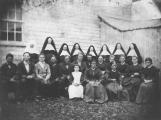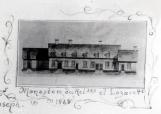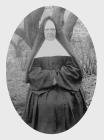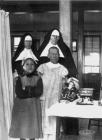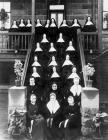

Musée Historique de Tracadie Inc.
Tracadie-Sheila, New Brunswick
2
The arrival of the nuns to look after the lepersHaving understood that there was but one way to look after the material and moral needs of the lepers; Mgr. Rogers entrusted this task to the nuns. A new building was built onto the existing hospital to serve as a convent for the nuns. Montreal's Religious Hospitallers of Saint Joseph were called upon to perform this duty. Six nuns arrived in Tracadie on September 29th, 1868. They were under the direction of mother Marie Pagé. Their first year was difficult as they received no funds from the government until the following year. Their survival depended on the charity of the parishioners and the generosity of the vicar-general. who was the pastor of Caraquet. Father Paquet had authorized them to take what they needed from the merchants and had taken responsability for paying their debts. The government gave them only 200 dollars the following year. Tracadie's pastor, father Gauvreau, gave 15 acres of farming land to the sisters in 1869. A barn was built by the parishioners. They also had the chore of providing firewood for the nuns. Father Gauvreau was indeed a benefactor to the nuns. Near the end of 1873, the nuns opened a school with the help of their benefactors, like the Honourable W. Davidson, father Babineau and the parishioners.
A few days later, 64 students were enrolled and their number rose to 180 the following school year.
4
Mgr. James Rogers1826-1903
Mgr. James Rogers was the first bishop of the new diocese of Chatham which covered the Northern Territories of New Brunswick. He was the only son of John Rogers and Mary Britton. He was born in Ireland on July 11th, 1826 and emigrated with his parents to Halifax in 1831. He began his theological studies at the seminary of the Sulpiciens in Montreal. He became fluent in French during that time. He was ordained in Halifax by Mgr. Walsh on July 2nd 1851. He was named pastor of Church Point, Nova Scotia. As a priest, he lacked neither self-assurance, zeal, nor joviality. This allowed him to solidify the Church's presence by preaching in both English and French, as well as in Mic-Mac occasionally.
He was sent to the Bermudas in 1857 where he was responsible for the building of the first Catholic church in the islands. He then acted as secretary for the archbishop, as well as taught at Saint Mary's College when he was recalled in 1859. Rogers was named bishop of Chatham on May 8th, 1860. He received his episcopal ordination in Charlottetown on August 15th, 1860.
The young pastor found in his congregation the perfect match for his zeal and his energy : a vast diocese with 60 missions with only 8 priests to attend to their needs. The quarantined lepers of the region in Tracadie's lazaretto, immediately gained his compassion. He took steps to bring to the area a religious congregation from Montreal to take care of the lepers and of the sick. He endowed the parish with schools, hospitals and priests as the years passed. As he was totally devoted to his duty, he had the courage and capacity to look after the parish with energy and foresight. After 42 years as bishop, Mgr. Rogers died in Chatham's Hôtel-Dieu on March 22nd, 1903.
6
Monastery and the lazaretto at the arrival of the Religious Hospitallers of Saint Joseph in 1868To make space for the sisters, the Board of Health did some repairs and added an extension to the lazaretto before the arrival of the nuns."The new building was 42 feet in length by 25 feet in width and 30 feet in height. Attic windows were fitted up under the roof which made space for 5 little bedrooms, while the ground floor was divided in 4 parts".
8
Joseph Auguste Babineau, 1844-1915Joseph Auguste Babineau was born in Saint Louis de Kent, New Brunswick, April 29th, 1844. He is called upon to replace pastor Gauvreau in the parish of Tracadie September 9th, 1871. Father Babineau's immediate goal was to finalize the procedures for the construction of a new stone church. The construction began in 1874 and ended in 1896. Shortly thereafter, a presbytery was constructed. The nuns managed to have the stone lazaretto (1896) built thanks to his support and his aid.
The nuns and the doctor assumed the responsibility of taking care of the lepers when the admnistration of the lazaretto was transferred from the provincial Bureau of Health to the federal government in 1880. Father Babineau was nonetheless named as its director and signed the agreement.
He made several trips to Ottawa to obtain both the construction of a new building and an increase in the annual allocation given to the nuns in order to take care of the sick. Father Babineau acted as the lazaretto's protector and was its supporter taking to heart its interests during his 32 years of service in the parish of Tracadie. The lazaretto was fortunate to have such a zealous supporter. He was named pastor in St.
Leonard in the spring of 1903. He would remain there until his death, March 31st, 1915.
9
Mother Marie Pagé, founder and superior of the lazaretto at Tracadie1868
Tracadie, New Brunswick, Canada
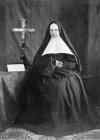
10
Sister Marie Pagé, 18811-1893, superior and founder of the Mission at TracadieFounder and Mother Superior of Tracadie's mission, sister Marie Pagé was born in St. Philippe de Laprairie, not far from the village of Acadie in Haut Richelieu December 25th, 1811. She joined the Hospitallers of Saint Joseph of Montreal at the age of 22 on March 13th, 1834. She was quickly entrusted with these responsabilities: administrator, the newcomers's mentor and mother superior of the Montreal community.
She was elected as founding mother superior for the mission in Tracadie in 1868. A terrible disease, leprosy, was rampant at that moment in North Eastern New Brunswick. Sister Pagé first came to visit the future mission in May 1868. She was accompanied by sister Davignon.
Their presence amongst these poor unfortunate caused touching scenes of faith and trust.
Mother Pagé and five of her collegues arrived in Tracadie to commence a charitable work. She was however recalled to their headquarters 9 months later.
She returns to Chatham and goes to visit the lepers in Tracadie in 1872.
The Chatham house again needed her services as teacher for the newcomers from 1878 to 1881.
At 70 years of age, she would have the courage and the strength to become the founding mother superior of the Hôtel-Dieu of Arthabaska in 1884. She returned to her native monastery in July 1890. Her skilled direction with regards to works of charity and her great respect of others made her a knowledgeable guide wherever she did her work.
She died at the age of 81 in Montreal on January 3rd, 1893.
12
Sister Amanda Viger, 1845-1906First pharmacist
Sister Amanda Viger, known as Saint Jean de Goto, daughter of Bonaventure Viger and Eudoxie Trudel was born in Boucherville, Quebec July 26th, 1845. She began her noviciate with the Religious Hospitallers of Saint Joseph of Montreal at only 15 years of age September 8th, 1960.
She made her vows there February 2nd, 1863. This young nun's talents were mostly noticed in the pharmacy. She arrived in Tracadie, New Brunswick with 5 founding collegues September 29th, 1868. She opened a school September 9th, 1873. Her class had 50 students already after only 15 days.
Sister Saint Jean de Goto held the office of community secretary for 18 years. She was elected mother superior of her community in 1875. A first federal grant would allow sister Saint Jean to have built a 45 X 25 foot wing for the lazaretto during her 2nd mandate as mother superior and director in 1881. It would comprise of a new pharmacy, a storeroom for the lazaretto, a pantry and the lepers' kitchen. She also had built a two-story building for the nuns that had the kitchen , the refectory, a work room and four small rooms. The federal government finally decides in 1893 to construct a stone lazaretto that would be completed March 8th 1896. Sister Saint Jean was not forgetting the unfortunate and the orphans. Funds were successfully collected thanks to donations and charity sales in order to build an orphanage (opened September 2nd, 1898) and a small hospital (opened November 1st, 1898).
Sister Saint Jean was called to Arthabaska, Quebec in August, 1902 to once again fulfill the role of mother superior for that community.
Tracadie was in a generalized state of regret when she left. She died at the age of 61, May 8th, 1906.
14
Sister Delphine Brault was born in Acadie, Quebec, March 20th, 1839.She joined the Religious Hospitallers of Saint Joseph of Montreal June 5th, 1856. She made her vows September 18th, 1858. She worked at the Hôtel-Dieu of Montreal as the administrator's assistant and was responsible for the orphans which prepared her for her functions in Tracadie, New Brunswick. She arrived in Tracadie with 5 others nuns September 29th, 1868. The lazaretto became her devotion for a quarter of a century. She would be: director of the sisters, hospital director, community secretary, the newcomers' mentor and mother superior from 1878 to 1881, and again from 1902 to 1909. A notable fact from her career was her near heroic devotion to the chicken pox victims in Pokemouche and Caraquet in 1874. Sister Brault returned to Montreal in 1886. She returned to Tracadie as mother superior in 1902 and remained until 1909.
She died at the age of 79, October 22nd, 1918.
16
Sister Clemence Bonin, 1816-1884Sister Clémence Bonin was born near Montreal in 1836. She presented herself to the Hôtel-Dieu and was admitted as a lay sister at the age of 26.
She was chosen in 1868 to go help the founding sisters in Tracadie with the establishment of the convent where she would live for 7 years.
She shared with fervour and courage the hardships, the fatigue and the hard labours that are inherent in the foundation of a new community. She would have wanted to better the fate of the lepers countless times.
She was then designated to accompany an ill sister back to their community in Montreal in February 1876. Sister Bonin felt a profound sacrifice that she believed herself unable to bear. She said that it was as if:"she was being separated from her treasure". Her treasure being her community that she called : "her dear Nazareth".
In Tracadie she was a patients' aid and was responsible of the laundry and housework for the lepers. She was also in charge of making the candles and "altar" bread.
Her health was precarious. She gave of herself for a few more years before dying July 10th, 1884.
17
Sister Eulalie Quesnel(1828-1903)
Sister Eulalie Quesnel was born in Arthabaska in the area of Bois Francs in the province of Quebec, Canada. She joined the Religious Hospilallers of Saint Joseph at the Hôtel-Dieu of Montreal in 1846 and made her vows in 1848. She accompanied mother Pagé during her first visit to the lazaretto in Tracadie with Mgr. Rogers. It was at that time that the sick and the people called for the nuns naming them:"holy sisters".
Sister Quesnel was co-founder of the mission in Tracadie, New Brunswick in 1868. She would accept the office of mother superior in St. Basile, in Madaswaska, New Brunswick from 1874 to 1880. This was one year after its foundation which was still unstable, poor and in a very precarious state. She would then return to Arthabaska for a third foundation from 1884 to 1888. She would become assistant to mother Pagé. As with the other foundations, the difficulties and the trials were numerous. She lived in an exemplary fashion and leaves us with the memory of a life of faithfulness and of great love that characterized it.
She would return to Montreal November 19th, 1888. She passed away March 4th, 1903 at the age of 75. 57 years of which were spent in religious service.
18
Sister Philomène Fournier, 1840-1895Sister Philomène , known as sister Lumina was born in Saint Anselme, Quebec April 6th , 1840. She asked to join the monastery at the age of 19. She wished to serve as a "lay sister". She made her vows June 22nd, 1862. She was chosen as one of the six founding nuns for the mission in Tracadie in 1868.
She kept as a motto this saying from Jesus:" I have come to serve, not to be served".
We read in her necrology that: "Amongst her sacrifices, one should be noted, that of leaving the community with the founders of our house in Tracadie where she shared poverty and fatigue. She made available her talents for manual work given to her by God with heroic charity.
Everywhere she was seen, she was constantly joining prayer and action".
She was a cook and worked in the laundry in Tracadie. We read in the community's Chronicles:"The kitchen and refectory floors were almost constantly covered in frost...it was so cold that sister Lumina often saw herself forced to put hot ashes in her clogs to do her work".
After spending 9 years in Tracadie, she returned to Montreal with S.M.
Reid May 28th, 1877. She died at their Montreal headquarters May 22nd, 1895.
19
Doctor Joseph Charles Taché, Deputy Minister of the Department of Agriculture, Federal Government1872
Ottawa, Ontario, Canada

20
Joseph Charles Taché, 1820-1894Doctor, politician, journalist, public servant and writer, Joseph Charles Taché, son of Charles Taché, trader, and Louise Henriette de Labroquerie was born December 24th, 1820 in the parish of St. Louis in Kamouraska, Lower Canada. He married Françoise Lepage July 1st, 1847 in Rimouski. They had 6 children. He was elected, without opposition, deputy of Rimouski in the Legislative Assembly of Lower Canada on January 24th, 1848 at the age of 27.
He retired as a deputy in December of 1856. Taché had been chosen shortly before to lead a new daily newspaper:the "Courrier du Canada". Taché's employment at the paper ends in October 1859. He took on a few days later the function of inspector of Canada's asylums and prisons. He was then named in August 1864, as deputy minister of Agriculture and Statistics , an important department that also included public health. This would be his last and his longest career as a high ranking civil servant for 24 years. His most remarkable achievement during this period was the census of 1871 for which he determined its content, form and procedure.
He conceived the desire to study leprosy. He wrote to Mr A. K.
McDougall, Provincial Secretary for the government of Fredericton in 1872. Taché expressed his desire to receive authorization to access Tracadie's lazaretto and its archives. From that part, he never stopped working to better the state of the lepers. Taché judged necessary and urgent to have the lazaretto's jurisdiction transferred over to the federal government since it was under provincial jurisdiction. He worked diligently on this project and succeeded November 25th, 1880.
He lent the nuns the support of his influence and the community always held him amongst its main benefactors and best protectors.
22
Sisters Marie Pitre and Marguerite Maillet caring for the sick and two young leper girls.23
The Religious Hospitallers of Tracadie in 1893The Religious Hospitallers of Tracadie in circa 1893 in the garden of the community, near the fence of the lazaretto
Here are the names of the nuns, in the garden of the community:
From left to right, 1st row:
Sisters Amanda Sormany, Landry, Vautour, Otar de la Grange(beginner), Miss Vautour(associate), Blanchard(candidate), and Octavie(lay sister),
2nd row:
sisters Marie Bariault, Elisabeth Landry, Louise Légère, LeRoyer(from Arthabaska), Saint Jean de Goto,(superior), Doucet, Maillet, H. Robichaud, Marguerite Marie, Marie des Anges and Hedwidge.
25
The Religious Hospitallers of Tracadie circa 1899. The majority of the sisters were Acadians from the diocese.From left to right: 1st row:
Sisters Haché, Marie Anne, Michaud.
2nd row:
Miss Vautour(associate), sisters Octavie(lay sister) and Elisabeth.
3rd row:
Sisters Hedwidge, Marie and Marguerite Marie
4th row:
Sisters Sainte-Elisabeth, Marie des Anges and Marthe.
5th row:
Sisters LaDauversière, Pitre and St. Joseph.
6th row:
Sisters Pagé and Losier.
7th row:
Sisters Landry, Robichaud, Daigle, Sormany, Vautour, Doucet(superior), St. Jean de Goto, Maillet and Légère.
